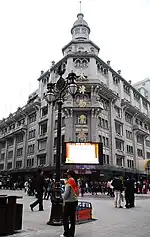39°07′01″N 117°11′49″E / 39.11694°N 117.19694°E
Heping
和平区 | ||||||||||||||||||||||||||||||||||||||||||||||||
|---|---|---|---|---|---|---|---|---|---|---|---|---|---|---|---|---|---|---|---|---|---|---|---|---|---|---|---|---|---|---|---|---|---|---|---|---|---|---|---|---|---|---|---|---|---|---|---|---|
| Country | People's Republic of China | |||||||||||||||||||||||||||||||||||||||||||||||
| Municipality | Tianjin | |||||||||||||||||||||||||||||||||||||||||||||||
| Township-level divisions | 6 subdistricts | |||||||||||||||||||||||||||||||||||||||||||||||
| Area | ||||||||||||||||||||||||||||||||||||||||||||||||
| • Total | 9.97 km2 (3.85 sq mi) | |||||||||||||||||||||||||||||||||||||||||||||||
| Population (2020) | ||||||||||||||||||||||||||||||||||||||||||||||||
| • Total | 449,100 | |||||||||||||||||||||||||||||||||||||||||||||||
| • Density | 45,000/km2 (120,000/sq mi) | |||||||||||||||||||||||||||||||||||||||||||||||
| Time zone | UTC+8 (China Standard) | |||||||||||||||||||||||||||||||||||||||||||||||
| Tianjin districts |
| |||||||||||||||||||||||||||||||||||||||||||||||
| Website | TJHP.gov.cn | |||||||||||||||||||||||||||||||||||||||||||||||
Heping District (simplified Chinese: 和平区; traditional Chinese: 和平區; pinyin: Hépíng Qū; lit. 'Peace District') is a district in the center of Tianjin, China. It is named after the He Ping Road, the most prosperous street of the district at the time of renaming in 1956.
The district has a long history. Its total area is 9.97 km2 (3.85 sq mi).[1] There are six subdistricts divided into 88 residential committees (社区居委会). As of 2020, the district has a total population of 449,100.[2]
In history, Heping District is the center of culture, commerce, and finance in Tianjin. The Tianjin CBD, shopping centres, and banks are concentrated in this District.
From 2006 to 2008, the leader of the district is Li Runlan (李润兰).
Yaohua High School is located in the district.
All Nippon Airways has its Tianjin Office in Tower 2 of The Exchange in the district.[3]
History
During the Song dynasty, the lands of today's Heping District was under Qingchi count of Cangzhou. Following the Jingkang incident, Qingchi county, along with most of Song territories north of Yellow River was occupied by Jin dynasty. Jin renamed the county as Jinghai in 1193.[4]
In 1730, Jinghai county was combined into Tianjin. Due to its long distance from the originally city center, the district was sparsely populated and underdeveloped. Since 1860, many part of the district was given to Britain, United States, France and Japan as concessions. With the return of the concessions following the end of World War II, former Japanese and French concessions were grouped into the First District, and the former British concessions was changed into the Tenth District.[5] After the founding of People's Republic of China, the District was divided into the First and Fifth Districts on October 10, 1952. On the first day of 1956, the First and Fifth Districts were renamed to Heping (lit. 'Peace') District and Xinhua (lit. 'New China') District respectively, and the Xinhua District was later combined into Heping District on September 9, 1958.
Administrative divisions
There are six subdistricts in the district:[6]
| Name | Chinese (S) | Hanyu Pinyin | Population (2010)[7] | Area (km2) |
|---|---|---|---|---|
| Xiaobailou Subdistrict | 小白楼街道 | Xiǎobáilóu Jiēdào | 30,982 | 2.134 |
| Quanyechang Subdistrict | 劝业场街道 | Quànyèchǎng Jiēdào | 59,551 | 1.737 |
| Wudadao Subdistrict | 五大道街道 | Wǔdàdào Jiēdào | 41,421 | 1.738 |
| Xinxing Subdistrict | 新兴街道 | Xīnxīng Jiēdào | 60,343 | 1.77 |
| Nanyingmen Subdistrict | 南营门街道 | Nányíngmén Jiēdào | 47,306 | 1.25 |
| Nanshi Subdistrict | 南市街道 | Nánshì Jiēdào | 33,874 | 1.22 |
Transportation
Metro
Heping District is currently served by two metro lines operated by Tianjin Metro:
See also
References
- ↑ "天津市和平区人民政府-和平概况_和平概况". www.tjhp.gov.cn. Retrieved 2022-09-16.
- ↑ "天津市和平区人民政府-2020年和平区国民经济和社会发展统计公报_统计信息". www.tjhp.gov.cn. Retrieved 2022-09-16.
- ↑ "ANA City offices Asia Archived 2016-11-18 at the Wayback Machine." All Nippon Airways. Retrieved on 13 August 2011. "Tianjin Office 10th floor,The Exchange Tower 2, 189 Nanjing Road, Heping District, Tianjin 300051"
- ↑ "文脉 | 从海河开始,认识一下和平区 - 历史文化 - 廉韵津沽". www.tjjw.gov.cn. Retrieved 2022-09-16.
- ↑ "和平区志 第一篇 建 置 第二章 区域变迁". zh. 2006. Archived from the original on November 9, 2014.
- ↑ 2011年统计用区划代码和城乡划分代码:和平区 (in Chinese). National Bureau of Statistics of the People's Republic of China. Archived from the original on 2012-10-01. Retrieved 2013-08-08.
- ↑ Census Office of the State Council of the People's Republic of China; Population and Employment Statistics Division of the National Bureau of Statistics of the People's Republic of China (2012). 中国2010人口普查分乡、镇、街道资料 (1 ed.). Beijing: China Statistics Print. ISBN 978-7-5037-6660-2.
External links
- Official website (in Chinese)
.jpg.webp)








